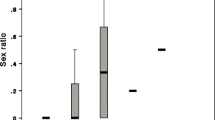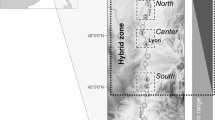Abstract
Sympatric speciation has been suggested for several pairs of social parasites and their hosts. Little is known, however, about how they have become reproductively isolated from each other. The ant Myrmica rubra has an intraspecific microgynous social parasite, which is probably speciating from its macrogynous host morph. Mating of the host and parasite is suggested to be spatially isolated, microgynes mating in the nest and macrogynes usually joining mating swarms. The mating biology of the microgyne is, however, still poorly known. We studied mating isolation and potential gene flow between these morphs by assessing whether host males are produced in naturally parasitized nests, and by testing experimentally cross-mating of the morphs when brought together. Both parasite and host males mated with both female morphs, but host males seemed to mate more often than the parasite males with their own kind. Although most males in the parasitized nests were produced by the parasites, the host queens and workers also produced some males, thus providing the morphs an opportunity for cross-mating. Previous studies have shown, however, that genetic divergence between sympatric parasite and host populations is substantial, which indicates that hybridization is rare. This implies that even if cross-mating between the morphs took place in the wild, introgression would be weak. Our results, together with earlier studies, indicate that the parasite and host of M. rubra are not fully reproductively isolated, even though gene flow between the morphs is restricted enough to allow ongoing speciation of the parasite.


Similar content being viewed by others
References
Azuma N, Takahashi J, Kikuchi T, Yoshimura M, Onoyama K, Higashi S (2005) Microsatellite loci for Myrmica kotokui and their application in some congeneric ant species distributed in northern Japan. Mol Ecol Notes 5:118–120. doi:10.1111/j.1471-8286.2005.00849.x
Bagherian YA, Münch W, Seifert B (2012) Myrmica microrubra Seifert (Hymenoptera, Formicidae) recorded from Poland for the second time. Myrmecol News 17:121–131
Bird CE, Fernandez-Silva I, Skillings DJ, Toonen RJ (2012) Sympatric speciation in the post “modern synthesis” era of evolutionary biology. Evol Biol 39:158–180. doi:10.1007/s11692-012-9183-6
Boomsma JJ, Leusink A (1981) Weather conditions during nuptial flights of four European ant species. Oecologia 50:236–241
Boomsma JJ, Nash DR (2014) Evolution: sympatric speciation the eusocial way. Curr Biol 24:R798–R800. doi:10.1016/j.cub.2014.07.072
Brian MV (1969) Male production in ant Myrmica rubra L. Insectes Soc 16:249–268
Brian MV (1983) Social Insects. Chapman & Hall, New York
Buschinger A (1997) Vorkommen der sozialparasitischen Ameise Myrmica microrubra in Hessen (Hymenoptera, Formicidae). Hessische Faunistische Briefe 16:49–57
Buschinger A (2009) Social parasitism among ants: a review (Hymenoptera: Formicidae). Myrmecol News 12:219–235
Bush GL (1975) Modes of animal speciation. Annu Rev Ecol Syst 6:339–364
Calhoun P (2013) Exact: unconditional exact test. R package version 1.4
Champely S (2012) pwr: basic functions for power analysis. R package version 1.1.1
Cohen J (1988) Statistical power analysis for the behavioral sciences, 2nd edn. Hillsdale, New Jersey
Cohen J (1992) A power primer. Psychol Bull 112:155–159
Core Team R (2013) R: a language and environment for statistical computing. R Foundation for Statistical Computing, Vienna
Czechowski W, Czechowska W (2002) Myrmica microrubra Seifert (Hymenoptera, Formicidae) recorded from Poland for the second time. Przegl Zool 46:75–77
Czechowski W, Woyciechowski M, Czechowska W (1999) Myrmica microrubra Seifert, 1993 (Hymenoptera, Formicidae)—an inquiline ant species new to Poland. Fragm Faun (Wars) 42:123–126
Czechowski W, Radchenko A, Czechowska W, Vepsäläinen K (2012) The ants (Hymenoptera: Formicidae) of Poland with reference to the Myrmecofauna of Europe. Natura Optima Dux Foundation, Warsaw
Elmes GW (1973) Miniature queens of the ant Myrmica rubra L. (Hymenoptera, Formicidae). Entomologist 106:133–136
Elmes GW (1976) Some observations on microgyne form of Myrmica rubra L. (Hymenoptera, Formicidae). Insectes Soc 23:3–21
Elmes GW (1978) Morphometric comparison of three closely related species of Myrmica (Formicidae), including a new species from England. Syst Entomol 3:131–145
Elmes GW (1991) Mating strategy and isolation between the two forms, macrogyna and microgyna, of Myrmica ruginodis (Hym. Formicidae). Ecol Entomol 16:411–423
Elmes GW, Brian MV (1991) The Importance of the egg-mass to the activity of normal queens and microgynes of Myrmica rubra L. (Hym. Formicidae). Insectes Soc 38:51–62
Elmes GW, Wardlaw JC (1983) A comparison of the effect of a queen upon the development of large hibernated larvae of six species of the genus Myrmica (Hymenoptera, Formicidae). Insectes Soc 30:134–148
Evans JD (1993) Parentage analyses in ant colonies using simple sequence repeat loci. Mol Ecol 2:393–397
Fitzpatrick BM, Fordyce JA, Gavrilets S (2009) Pattern, process and geographic modes of speciation. J Evol Biol 22:2342–2347. doi:10.1111/j.1420-9101.2009.01833.x
Gavrilets S (2003) Perspective: models of speciation: what have we learned in 40 years? Evolution 57:2197–2215. doi:10.1111/j.0014-3820.2003.tb00233.x
Gavrilets S (2014) Models of speciation: where are we now? J Hered 105:743–755. doi:10.1093/jhered/esu045
Hastings MD, Queller DC, Eischen F, Strassmann JE (1998) Kin selection, relatedness, and worker control of reproduction in a large-colony epiponine wasp, Brachygastra mellifica. Behav Ecol 9:573–581
Henrich KO, Sander AC, Wolters V, Dauber J (2003) Isolation and characterization of microsatellite loci in the ant Myrmica scabrinodis. Mol Ecol Notes 3:304–306. doi:10.1046/j.1471-8286.2003.00433.x
Herbers JM, Mouser RL (1998) Microsatellite DNA markers reveal details of social structure in forest ants. Mol Ecol 7:299–306
Hölldobler B, Wilson EO (1990) The Ants. Harvard University Press, Cambridge, Mass
Huang MH, Dornhaus A (2008) A meta-analysis of ant social parasitism: host characteristics of different parasitism types and a test of Emery’s rule. Ecol Entomol 33:589–596. doi:10.1111/j.1365-2311.2008.01005.x
Hubbard MD, Nagell B (1976) Note on an extraordinarily high mating swarm in the ant Myrmica laevinodis (Hymenoptera: Formicidae, Myrmicinae). Entomol News 87:86
Huszár DB, Larsen RS, Carlsen S, Boomsma JJ, Pedersen JS (2014) Convergent development of ecological, genetic, and morphological traits in native supercolonies of the red ant Myrmica rubra. Behav Ecol Sociobiol 68:1859–1870
Jansen G, Savolainen R, Vepsäläinen K (2010) Phylogeny, divergence-time estimation, biogeography and social parasite-host relationships of the Holarctic ant genus Myrmica (Hymenoptera: Formicidae). Mol Phylogenet Evol 56:294–304. doi:10.1016/j.ympev.2010.01.029
Leppänen J, Vepsäläinen K, Savolainen R (2011) Phylogeography of the ant Myrmica rubra and its inquiline social parasite. Ecol Evol 1:46–62. doi:10.1002/ece3.6
Leppänen J, Savolainen R, Seppä P, Vepsäläinen K (2015) Genetic divergence between the sympatric queen morphs of the ant Myrmica rubra. Mol Ecol 24:2463–2476. doi:10.1111/mec.13170
Mallet J (2005) Hybridization as an invasion of the genome. Trends Ecol Evol 20:229–237
Mayr E (1942) Systematics and the origin of species. Columbia University Press, New York
Pearson B (1981) The electrophoretic determination of Myrmica rubra microgynes as a social parasite: possible significance in the evolution of ant social parasites. In: Howse PE, Clément J-L (eds) Biosystematics of social insects, vol 19. Academic Press, London, pp 75–84
Pearson B, Child AR (1980) The distribution of an esterase polymorphism in macrogynes and microgynes of Myrmica rubra Latreille. Evolution 34:105–109
Pillay N, Rymer TL (2012) Behavioural divergence, interfertility and speciation: a review. Behav Process 91:223–235. doi:10.1016/j.beproc.2012.08.006
Rabeling C, Bacci M (2010) A new workerless inquiline in the Lower Attini (Hymenoptera: Formicidae), with a discussion of social parasitism in fungus-growing ants. Syst Entomol 35:379–392. doi:10.1111/j.1365-3113.2010.00533.x
Rabeling C, Schultz TR, Pierce NE, Bacci M (2014) A social parasite evolved reproductive isolation from its fungus-growing ant host in sympatry. Curr Biol 24:2047–2052. doi:10.1016/j.cub.2014.07.048
Ritchie MG (2007) Sexual selection and speciation. Annu Rev Ecol Syst 38:79–102. doi:10.1146/annurev.ecolsys.38.091206.095733
Savolainen R, Vepsäläinen K (2003) Sympatric speciation through intraspecific social parasitism. Proc Natl Acad Sci USA 100:7169–7174. doi:10.1073/pnas.1036825100
Schär S, Nash DR (2014) Evidence that microgynes of Myrmica rubra ants are social parasites that attack old host colonies. J Evol Biol 27:2396–2407. doi:10.1111/jeb.12482
Seifert B (1993) Taxonomic description of Myrmica microrubra n. sp. – a social parasitic ant so far known as the microgyne of Myrmica rubra (L.). Abh Ber Natkdmus Görlitz 67:9–12
Seifert B (1999) Interspecific hybridisations in natural populations of ants by example of a regional fauna (Hymenoptera, Formicidae). Insectes Soc 46:45–52
Seifert B (2007) Die Ameisen Mittel- und Nordeuropas. Lutra Verlags- und Vertriebsgesellschaft, Tauer
Seifert B (2010) Intranidal mating, gyne polymorphism, polygyny, and supercoloniality as factors for sympatric and parapatric speciation in ants. Ecol Entomol 35:33–40. doi:10.1111/j.1365-2311.2009.01136.x
Shvarts SS (1977) The evolutionary ecology of animals. Studies in Soviet Science, Consultant Bureau, New York, USA (translated from Russian, original 1969)
Smeeton L (1981) The source of males in Myrmica rubra L. (Hym. Formicidae). Insectes Soc 28:263–278
Smith JM (1966) Sympatric speciation. Am Nat 100:637–650
Steiner FM et al (2006) No sympatric speciation here: multiple data sources show that the ant Myrmica microrubra is not a separate species but an alternate reproductive morph of Myrmica rubra. J Evol Biol 19:777–787. doi:10.1111/j.1420-9101.2005.01053.x
Vepsäläinen K, Ebsen JR, Savolainen R, Boomsma JJ (2009) Genetic differentiation between the ant Myrmica rubra and its microgynous social parasite. Insectes Soc 56:425–437. doi:10.1007/s00040-009-0042-0
Via S (2001) Sympatric speciation in animals: the ugly duckling grows up. Trends Ecol Evol 16:381–390. doi:10.1016/S0169-5347(01)02188-7
Walsh PS, Metzger DA, Higuchi R (1991) Chelex® 100 as a medium for simple extraction of DNA for PCR-based typing from forensic material. Biotechniques 10:506–513
Wilson EO (1971) The insect societies. Harvard University Press, Cambridge
Zeisset I, Ebsen JR, Boomsma JJ (2005) Dinucleotide microsatellite DNA loci from the ant Myrmica scabrinodis. Mol Ecol Notes 5:163–164. doi:10.1111/j.1471-8286.2004.00871.x
Acknowledgments
Serge Aron, Laura Kvist and Bernhard Seifert made valuable comments on the manuscript and David Queller advised with the maximum likelihood analysis. This study was funded by the Academy of Finland (project no. 210523 to RS), the Ella and Georg Ehrnrooth foundation, the Finnish Cultural Foundation, the Alfred Kordelin Foundation, Societas pro Fauna et Flora Fennica, the Oskar Öflund Foundation, the Otto A. Malm Foundation and the Kuopio Naturalists’ Society (to JL).
Author information
Authors and Affiliations
Corresponding author
Rights and permissions
About this article
Cite this article
Leppänen, J., Seppä, P., Vepsäläinen, K. et al. Mating isolation between the ant Myrmica rubra and its microgynous social parasite. Insect. Soc. 63, 79–86 (2016). https://doi.org/10.1007/s00040-015-0438-y
Received:
Revised:
Accepted:
Published:
Issue Date:
DOI: https://doi.org/10.1007/s00040-015-0438-y




